Black Falcon
Black FalconFalco Subniger | |
|---|---|
| Kingdom: | Animalia |
| Phylum: | Chordata |
| Class: | Aves |
| Order: | Falconiformes |
| Family: | Falconidae |
| Status | |
| World: | Least concern (IUCN 2023) |
| Australia: | Not listed under EPBC Act |
| Victoria: | Critically endangered (FFG Threatened List 2025) |
| Profiles | |
| Australia: | Species prifile & threats database |
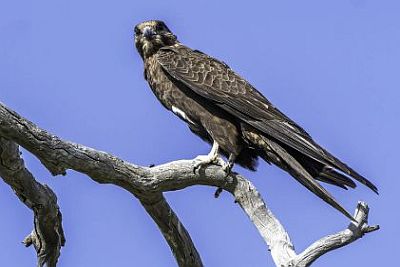
The Black Falcon Falco subniger is only found in mainland Australia and is the largest of the six species of falcon’s genus Falco in Australia. It is a stunning large, dark coloured falcon which occurs from south-eastern Australia up to northern Australia. In Victoria, it is mostly associated with open grassland or in lightly wooded areas, it has also been observed close to urban areas.
Six species of falcon genus Falco in Australia, including Victoria:
- Falco subniger – Black Falcon
- Falco pereginus – Peregrine Falcon
- Falco berigora – Brown Falcon
- Falco hypoleucos – Grey Falcon
- Falco longipennis – Little Falcon (Australian Hobby)
- Falco cenchroides – Australian Kestrel (Nankeen Kestrel)
Identification of the Black Falcon in the field can be difficult, particularly due to some similarity with the Brown Falcon, Black Kite and Peregrine Falcon. Distinguishing features when perched include, small head, pale chin, short legs and long tail. In flight: swift powerful wingbeats, no fork in tail, mostly dark above and below wings, wings pointed and downward when gliding.
A detailed description is provided in: Australian Birds of Prey In Flight -a photographic guide, Seaton, R., Gilfedder, M., Debus, S. (2019) CSIRO Publishing.
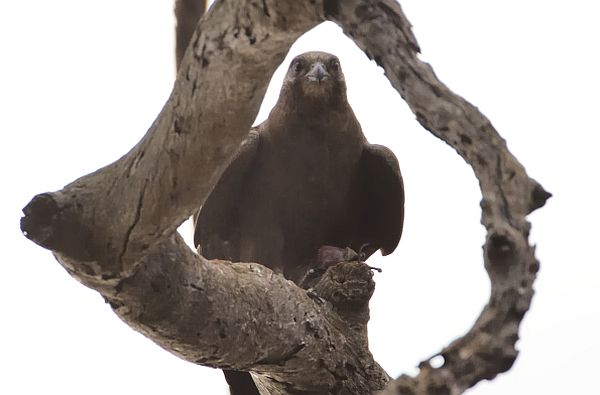
The Black Falcon is not known to perch on wires unlike the Brown Falcon (Debus 2019)
The Black Falcon most commonly vocalise at the nest and is described as a ‘harsh scream’ with a ‘lower pitch than the Peregrine Falcon with more of a crowing character than the Brown Falcon’ (Debus, 2011).
Distribution
Within Victoria, the majority of the population is found in the western region of Greater Melbourne and towards Geelong. Concentrations also occur around Swan Hill and Wangaratta areas.
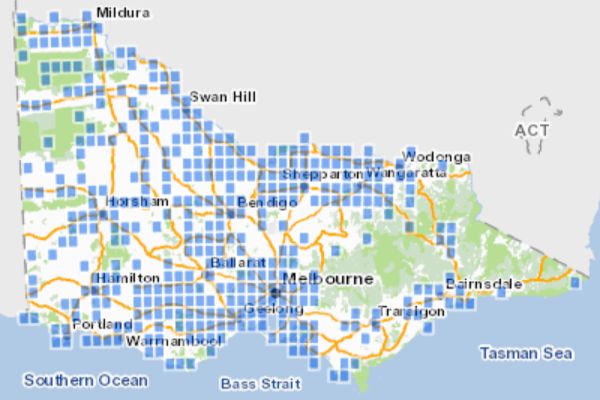
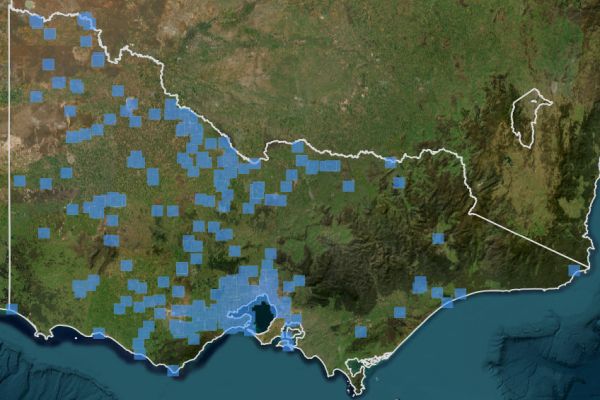
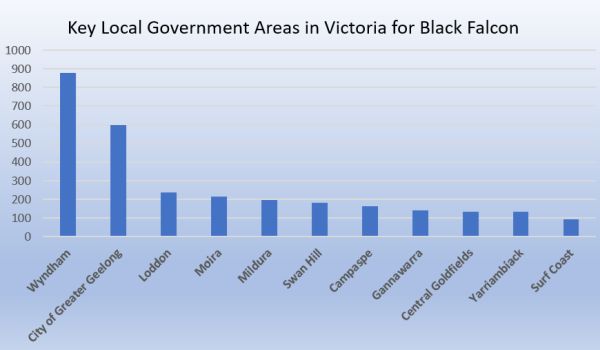
All known records x LGA’s with greater than 100 records. Data source: derived from ALA 2023.
Habitat & Ecology
Habitat
The Black Falcon inhabits a diverse range of habitats, ranging from shrublands and grasslands to woodlands and farmlands. The Black Falcon is typically known to occupy locations with streams and wetlands, using dead trees as perches for locating prey. Habitat choice is determined by prey availability and the presence of old trees.
Nesting
Black falcon nests can be found alongside rivers and creeks, mostly in large old trees where the species will use abandoned bird nests. A study in South Australia identified nests in old red gums and abandoned crow’s nests being used for nesting. Nests were open and exposed to sun, wind, and rain (Debus, 2011).
Eggs are laid between winter and late spring (May to November), brood size estimates range from 2.5- 3 nestlings (Debus, 2011). Incubation of Black Falcon eggs is around 5 weeks, with a nestling period of 6-7 weeks. Females do most of the incubation and feed the nestling while the male brings food. As the nestling grow both parents share the responsibility of feeding (Birdlife Australia 2020).
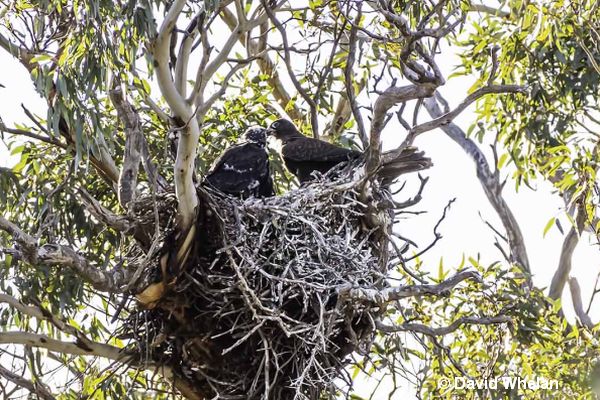
Feeding
The black falcon’s diet consists of a variety of prey, including small birds, parrots, small mammals and insects. The hunting techniques of the Black Falcon involve perch hunting, theft from other predators and high soaring, where they search for prey.
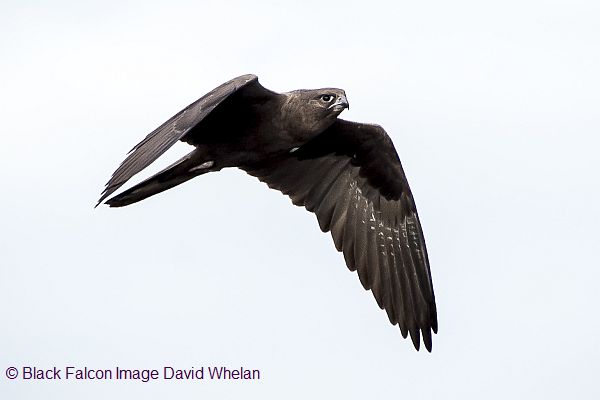
Population Status
The entire Australian population is estimated to number 1,000-10,000 individuals, roughly equating to 670-6,700 mature individuals (IUCN 2016).
There has been a decline in the overall population of the Black Falcon, particularly in south-eastern Australia. Between 1983 to 2003 Barrett et al. (2003b) found there could have been a 30-50% national decline with declines being greatest in south-eastern Australia.
Between 1977 to 2006 there has been a 43% reduction in the reporting rate of the Black Falcon in NSW (DPIE 2013)
There is a reported decrease in the NSW population since the 1990’s, from a possible 10,000 or more to 3 to 5 thousand individuals.
The conservation status of Black Falcon was reassessed from Vulnerable (DSE 2013) to Critically endangered under the Victorian FFG Act Threatened List (DWELP 2022).
Threats
The greatest threats to the Black Falcon include:
- Habitat loss – mainly old paddock trees used for nesting and perching
- Reduced prey – includes competition from other species and loss of habitat for small birds and small mammals
- Road kill – reliance on having to scavenge for an alternative source of food
- Nest failure – associated with loss of nests and nesting trees due to storm damage
Conservation & Management
The Black Falcon is one of least studied native falcons (Debus, 2011).
At present there is no specific Action Statement for Black Falcon in Victoria. Most of the conservation efforts in Victoria are carried out by various land management projects undertaken by Landcare and other environmental groups. Activities include identification of active or inactive nest sites, and revegetation and/or restoration of hunting grounds. Restoration of nesting and foraging lands is key as this will ensure that once breeding season is at its height, minimal disturbance is exerted upon the species, and young falcons have a stable food supply, thus ensuring that the populations continue to grow or remain stable.
Landholders can help the Black Falcon by retaining both old dead and live mature trees on their property.
Projects & Partnerships
If you are aware of any projects relating to the Black Falcon please Contact SWIFFT so we can share the conservation efforts being carried out.
References & Links
ALA (2023) Atlas of Living Australia, Black Falcon
BLA (2020) Black Falcon Birdlife Australia. [online since removed]
Debus, Stephen & Olsen, Jerry. (2011). Some aspects of the biology of the Black Falcon Falco subniger. Corella. 35. 29-36.
Debus (2019) A Field Guide Birds of Prey Australia, Stephen Debus, CSIRO Publishing.
DPIE (2013) NSW Department of Planning, Industry and Environment 2013, NSW SCIENTIFIC COMMITTEE Black Falcon, viewed 10 May 2023.
FFG Threatened List 2025 (Flora and Fauna Guarantee Act 1988 - Threatened List - March 2025, Department of Energy, Environment and Climate Action (DEECA), Victoria.
IUCN Red List (2023) BirdLife International. 2016. Falco subniger. The IUCN Red List of Threatened Species 2016: e.T22696484A93567053. Accessed on 20 March 2023.
VVB (2023) Visualising Victoria’s Biodiversity 2023
More Information
- Australian Government - Black Falcon, Species profile and threats database
- NSW threatened species profile Black Falcon
- eBird, Black Falcon

